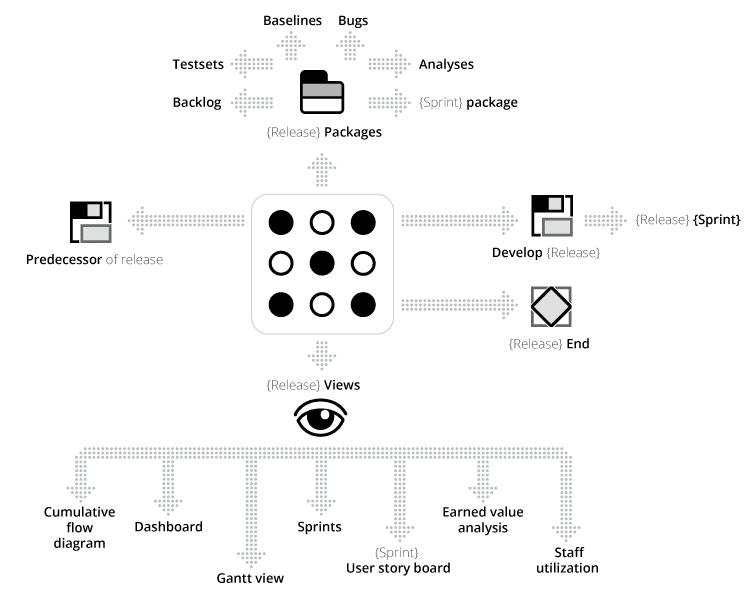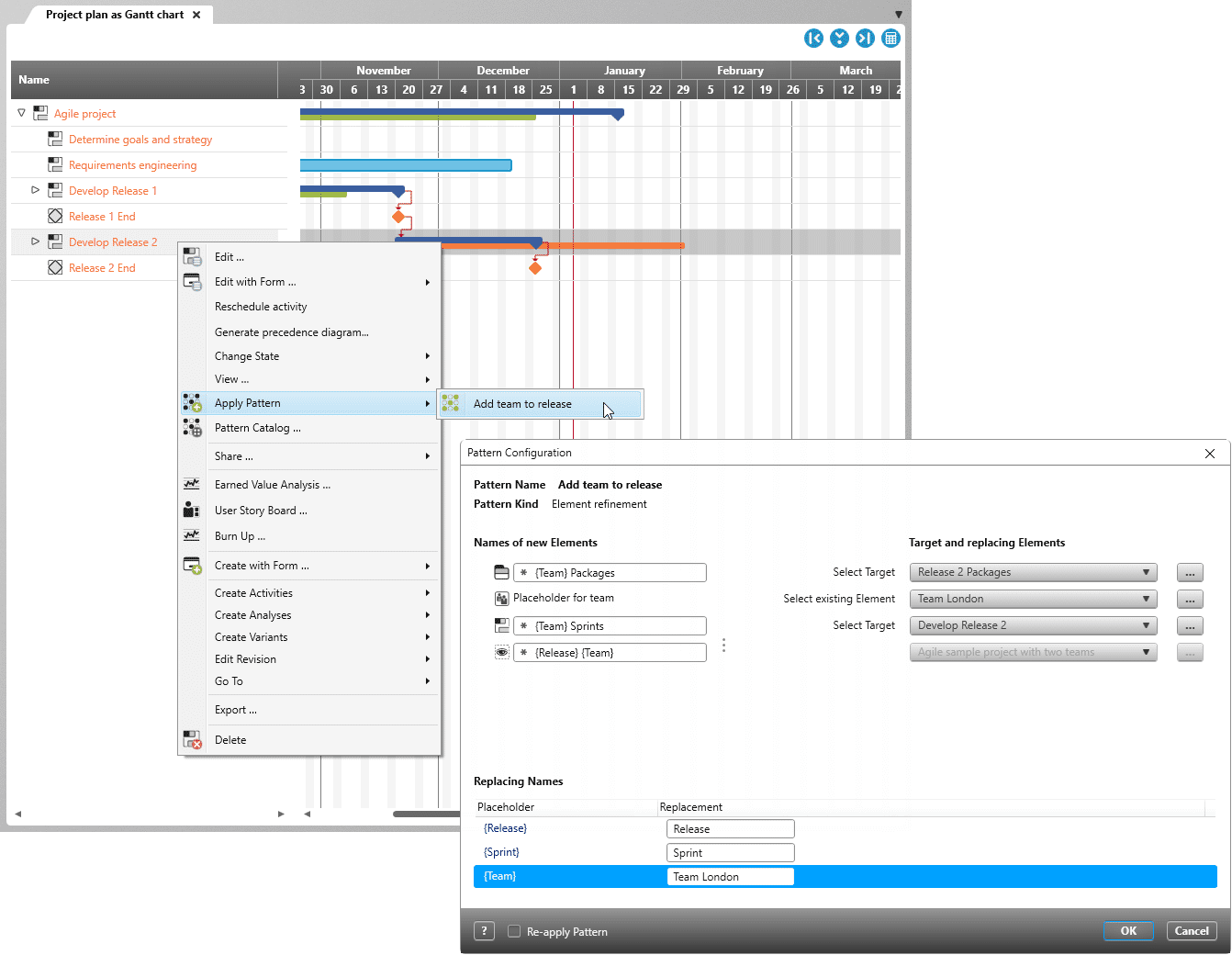Agile Planning with Patterns. Re-Use Existing Solution Concepts.
What does agile planning cover? Why are patterns helpful and how can you implement them in agile planning?

Patterns in agile planning provide a proven solution concept for repeating problems. If you, for example, have to create a new release for a teams, then patterns can take over the necessary steps for you.
Where do you store all the artifacts for a new release? Simply in the folder structure that the pattern automatically generates. This way, your requirements or bugs always end up in the right place.
In hybrid project environments, patterns make sure that a release activity, the first sprint activity of the release and a milestone for the end of the release are generated.
With patterns, you can also automatically generate evaluations or views for your new release. For example, a cumulative flow diagram or an earned value analysis for a new release.
Agile Planning – What Does This Mean?
Agile planning means planning in small development cycles, or iterations, to constantly include the customer, to react flexibly to new requirements and to regularly deliver prototypes. We speak of releases and sprints instead of milestones and activities.
In everyday agile situations, the same tasks are always coming up. For example, planning the next sprint for a release or a team. Often you also have to include a new team in the planning and create a working environment where it can get started straight away. These tasks entail work, which you can either do yourself, or let a pattern do for you.
What are Patterns in Agile Planning?
Patterns in agile planning are templates for solving specific problems. For example, they provide a solution approach for planning a new team release. This step requires a few more steps that you have to carry out:
- You need a new release backlog.
- ou have to define where the artifacts like requirements for new releases and their sprints will be stored. For this, you need a clear folder structure.
- When hybrid project management comes into play, you need an activity for your new release. This should include an end milestone with control flows as well as a control flow for the end milestone of the previous release.
Patterns offer suggested solutions by providing, for example, a defined folder structure that can be easily applied or adapted to your needs. This reduces the time-consuming work that you have to do by letting the patterns automatically do this important work in agile planning.
A short definition of pattern:
A pattern is a solution concept for a concrete, continuously occurring problem.
Origin of Patterns
The idea of patterns as a reusable solution concept came from the architect Christopher Alexander in the seventies. He recognized that there are foundational patterns for cities and buildings that are strived for and repeated. He defined a pattern catalog where he collected these patterns and described their specific properties, for example, purpose, application, structure or consequence.
A few years later, this concept slopped over to software development and design. The famous work “Design Patterns” by Gamma, Helm, Johnson and Vlissides came out in 1994 and explained that there are also proven solution concepts for certain problems in software development. Here, the four provided code solutions that can applied as patterns and adapted in specific contexts. Later, the concept was transferred to software architecture with the “Architecture Patterns”.
Types of Patterns in Software Development
There are three different levels of patterns in software development:
Architectural Patterns:
For the foundational structure of software systems with reference to the components
Design Patterns:
For repeating problems in software development (normally on a code basis)
Programming Patterns:
Specific patterns for programming languages
Advantages of Patterns in Agile Planning
- They offer solutions for specific problems
- They are easily applicable because the purpose and application are consistently described
- They make work more efficient
- They can be adapted to specific contexts
- They make communication between developers easier
- They document expert knowledge and make it accessible to all.
Properties of a Good Pattern
- It solves one or more problems that repeatedly occur
- It is described clearly (for example, with its purpose, application and results)
- It is adaptable to specific contexts
- It offers connection points to other patterns where necessary
Agile Planning using Patterns with objectiF RPM
Enterprise software for more business agility.
Try it out 30 days for free »
Examples of Patterns in Agile Planning
Create Domain
Purpose:
Examining a new domain
Results:
Generates folders with sub-folders for the results of requirements engineering in domains (for example for requirements, use cases and personas)
Generates documents (for example requirements definition of domain)
Create New Sprint for Release
Purpose:
Planning a release’s next sprint
Results:
Generates a sprint activity with a control flow for the previous sprint
Generates a folder for sprint artifacts (requirements, use cases, etc)
Generates analyses for sprint (earned value chart, user story board, Gantt chart)
Create New Sprint for Single Team
Purpose:
Planning a team’s new sprint
Results:
Generates a team activity in the project plan
Generates a folder for team artifacts
Create Release for Single Team
Purpose:
For planning a new release for a single team
Results:
Generates folder hierarchy with backlog, baseline, evaluations and sprint
Generates activity hierarchy with release activity, end milestones with control flow to end milestones of the previous activity
Generates first sprint activity for a release activity
Allocates the release activity to a backlog
Create Release for Multiple Teams
Purpose:
For planning a release where multiple teams are working at the same time
Results:
Generates a folder hierarchy with a release backlog, baseline and evaluations (structured according to teams)
Generates activity hierarchy with a release activity, end milestones with control flow, control flow for end milestones of the previous release (structured according to teams)
Generates a team activity with the first sprint activity for a release activity
Add Team to Release
Purpose:
Adding new team to an agile, scalable project
Results:
Generates a team activity under the release activity
Generates a sprint activity under the new team activity
Generates folder hierarchy with a backlog, baseline and evaluations, as well as artifacts from the first sprint
How to Apply Patterns in objectiF RPM
You apply a pattern by right-clicking an activity within the project plan. Then you can adapt the pattern to your specific context. For instance, all sprints are supposed to have the team name “Team London” in their name. To do this, you just need to edit the placeholders.


